#North Sulawesi babirusa
Text

North Sulawesi babirusa Babyrousa celebensis
Observed by bertharris, CC BY-NC
34 notes
·
View notes
Text
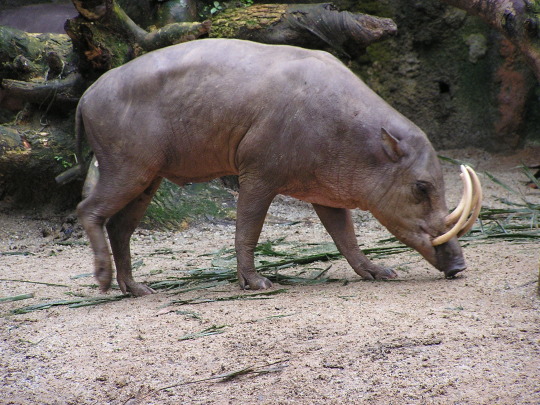
North Sulawesi babirusa (Babyrousa celebensis)
This species is found only on and around the Indonesian island of Sulawesi. They live in tropical forests and swamps, and like other pigs are omnivores which will eat roots, tubers, leaves, fruits, and small animals. Male babirusas are infamous for their tusks, which can grow back so far that they pierce and grow into the animal’s forehead!
#markhors-menagerie#animal facts#animals#biology#fun facts#ungulates#even toed ungulates#pigs hippos & kin#babirusa#North Sulawesi babirusa
4 notes
·
View notes
Text



North Sulawesi Babirusa (Babyrousa celebensis), male, family Suidae, found on Sulawesi and nearby islands in Indonesia
photographs: Oregon Zoo, Masteraah, HarshLight
348 notes
·
View notes
Text
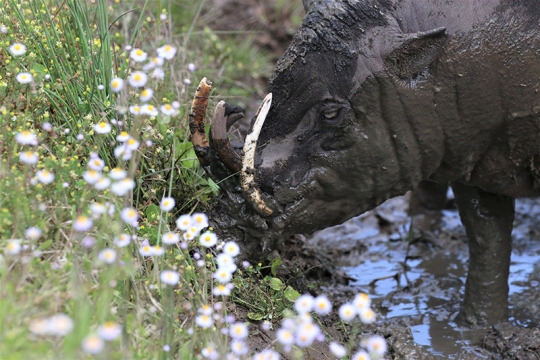

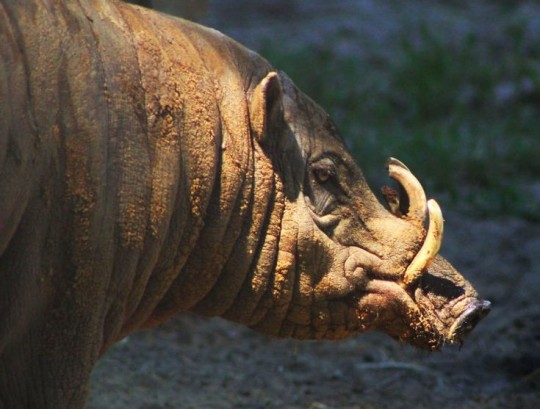
North Sulawesi babirusa - vulnerable
📍Indonesia
2 notes
·
View notes
Text



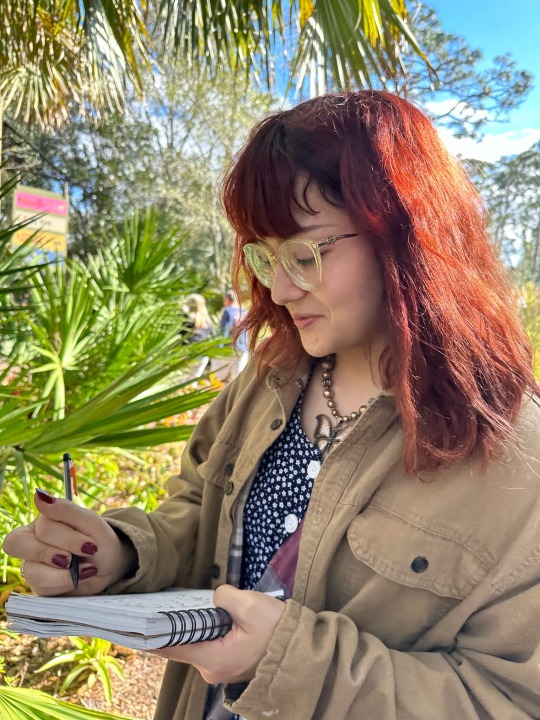
While visiting Florida this past Holiday, I had the immense privilege of getting to experience so much beautiful wildlife in a multitude of ways. Through zoos, yes! But, more than just that. It was magical getting to see the amount of wildlife in suburbia. I do not love Florida for its sociopolitical environment. I guess “do not love” implies there is any like, where there is not. However, seeing the Sandhill Cranes (who, I only just learned, migrate over San Antonio in early Spring. We just heard them calling overhead a few days past) walk so freely throughout the neighborhood. Seeing them bathe in the sun, as ordinary as our boundless squirrels back home. And the gators! Wow! There was a young gator in a neighborhood pond, and we got to see them a couple of times. While their age reduced their size, the possibility of them is what awe struck me. The life cycle is an incredible thing, and this is known and honored. But to see such an animal, who did not roam freely where I grew up, at such a young point of life… It is spectacular. They will not grow to massive sizes within the week of our visit, but they will remind me of it. I think that is incredible.
But yes the zoos! These pictures were taken at the Brevard zoo, in Melbourne. It was perhaps the coolest zoo I have visited. The habitats were expansive and immersive. As you walked through, you felt as if you were witnessing the wildlife; No longer only observing it.
Back home, our Zoo usually has only one Babirusa on display. Here, there was an entire family spread out across multiple smaller habitats! They are North Sulawesi Babirusa, and we got to watch the mother, Piggy, and her two sons, Billy and Bob, frolicking happily around. Their tails wagging nonstop. Their chins tilted up to the sky, not dragging only to the ground. The father, Meru, was more solitary. He stood in the farthest pen, over his pile of fresh food. The family occasionally came up to stare at him through the habitat door that connects each “room.”
On January 13, 2024 the zoo announced the arrival of twin piglets!
It will take a little till they are out, I’m sure, but the excitement is boundless!
I could talk for hours about this zoo! So I’ll have to nip my tangent here :) I got lots of really nice drawings during this trip that I’m eager to share! Cheers all!! And take care of yourself!
AND STOP EATING PALM OIL!!!
You are actively participating in the destruction of both ecosystems and species!
1 note
·
View note
Text
Planet zoo exhibit animals

#Planet zoo exhibit animals free#
The number of possible spawning locations will fluctuate as enrichment items are added and removed. Instead, they will randomly change locations when not on-screen. They do not move about their tanks on-screen. These things can be adjusted manually, but this requires more power and thus costs more money.Īs for the animals themselves, their needs are much more simplified than those of the megafauna. Certain animals such as reptiles will require a certain temperature and level of humidity to survive. Through research, players can unlock new enrichment items for the animals such as heat lamps, climbing branches, and more. When purchased, the terrarium is largely empty aside from some plants. My exhibits bring in good money in the donation bins but I put all my exhibit animals on birth control. Getting about 100k+ per year just by doing that. Unlike the larger megafauna, exhibit animals come pre-contained in large glass. Wait till they send anger messages on the notification board and clear them all out. While terrariums can't be fully customized, many aspects of them can be. Exhibit Animals are special animals that can be purchased in Planet Zoo. Exhibit animals consist of smaller animals that would be unfit for large outdoor enclosures, such as small reptiles, amphibians, and invertebrates. Unlike the larger megafauna, exhibit animals come pre-contained in large glass terrariums. The Southeast Asia Animal Pack will be available on Steam for $9.99 USD.Various for animals, $ 3,000 for exhibit Exhibit Animals are special animals that can be purchased in Planet Zoo. March 30 is looking like a good day for Planet Zoo fans. There are several more quality of life changes coming to the game. The pack includes a new water feature, along with an option to open an information panel with statistics, as well as offer customization options.īillboards and educational boards will also become customizable, allowing you to create their own signs to put around your zoos and habitats.
#Planet zoo exhibit animals free#
Along with the DLC, Planet Zoo will receive its free 1.5 update, bringing new features to the base game. Seven of these animals are habitat animals, while one - the giant leaf insect - is an exhibit animal.īut the Southeast Asia Animal Pack is not the only new content. The new timed scenario is another welcome addition to Planet Zoo, introducing you to even more animals. But with an animal-focused DLC, the community on Reddit and Twitter is feeling positive again. Many players in the community felt these DLC packs focused too much on buildings and not enough on animals - and for a premium price to boot. So far, the packs often only introduce four or five new animals along with a large number of new building materials for a premium price. These ugly brutes get along with eight other animals that you’re no doubt familiar with such as the. species communities that will follow in the additional exhibit clusters. Planet Zoo and its DLC have regularly been criticized for its lacking number of animals. The best animal you can have for your multispecies enclosure in Planet Zoo is the Common Warthog. ROCK CREEK MASTER PLAN - The National Zoo's Rock Creek facilities have been. The DLC also introduces a new scenario set in Malaysia. Soon, you can stock your zoo with the clouded leopard, sun bear, binturong (also known as the bearcat), Malaysian tapir, proboscis monkey, North Sulawesi babirusa, Ussuri dhole, and giant leaf insect. On March 30, the Southeast Asia Animal Pack brings eight new animals to Planet Zoo. Planet Zoo creator Frontier Developments has announced the Southeast Asia Animal Pack, a DLC with double the number of animals as usual and no building parts or other creative assets.

0 notes
Photo

1 note
·
View note
Photo



Sulawesi babirusa (Babyrousa celebensis)
Also known as: North Sulawesi babirusa
Together with the other members of the genus Babyrousa, the North Sulawesi babirusa has usually been considered a subspecies of a widespread Babyrousa babyrussa, but recent work suggests that there may be several species. Following the split, the “true” B. babyrussa is restricted to Buru and the Sula Islands. The common and scientific names are various transcriptions of its local name, which literally translated means “pig-deer” (from Indonesian babi, “pig” + rusa, “deer”) in reference to the huge tusks of the male suggestive of a deer’s antlers. In 2006, a male North Sulawesi Babirusa and a female domestic pig were accidentally allowed to interbreed in the Copenhagen Zoo. The offspring were 5 hybrid piglets with teeth most resembling the North Sulawesi Babirusa, while their colour was highly variable.
Classification
Animalia - Chordata - Mammalia - Eutheria - Boreoeutheria - Laurasiatheria - Scrotifera - Euungulata - Artiodactyla - Artiofabula - Suina - Suidae - Suini - Babyrousa - B. celebensis
Images: [x] [x] [x]
Source: [x]
#sulawesi babirusa#north sulawesi babirusa#babirusa#pig#vulnerable#babyrousa celebensis#babyrousa#suini#suidae#suina#artiofabula#artiodactyla#euungulata#scrotifera#laurasiatheria#boreoeutheria#eutheria#species feature#mammalia#tetrapoda#vertebrata#chordata
7 notes
·
View notes
Photo

North Sulawesi babirusa (Babyrousa celebensis) at Gorontalo in Sulawesi, Indonesia
Chien C. Lee
76 notes
·
View notes
Photo
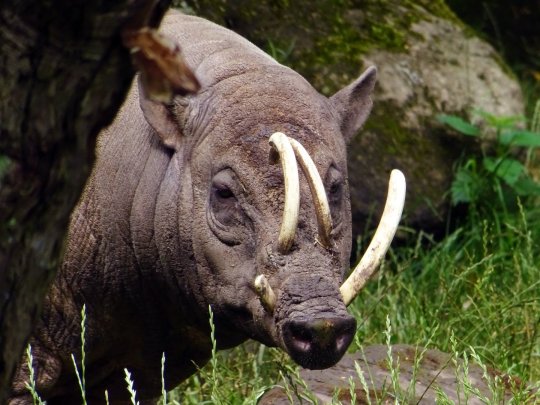
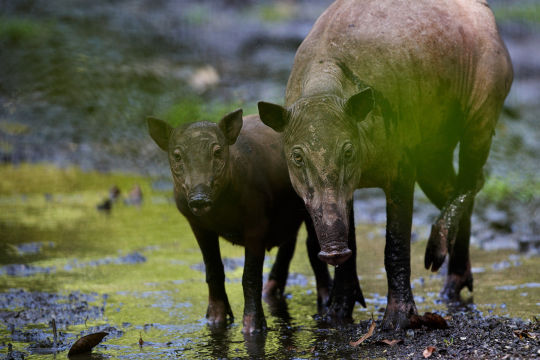
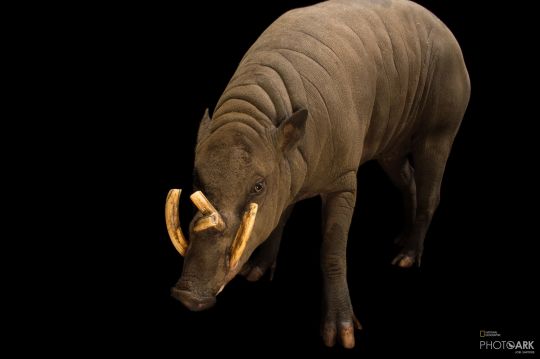
The Beautiful Babirusa
One of the lesser known members of the swine family, the Babirusa is a genus native to the Indonesian islands of Sulawesi, Togian, Sula and Buru. The genus is made of three species: the golden babirusa, the north Sulawesi babirusa, and the Togian babirusa. The differences between each species are minimal, based mainly on size, amount of hair, skull and teeth measurements, and genetics.
Generally speaking, babirusas, or deer-pigs, are not large. They can reach between 60-100 cm at the shoulder, and weighs between 50-100 kg. The teeth are, in particular, a unique characteristic of the babirusa. The upper canines in males grow upward, piercing through the top of the mouth and curving back toward the skull. Meanwhile the lower canines grow straight and outward. These tusks are used in conflicts between males; the upper canines become shields against the piercing lower canines of the opponent. There is also evidence that babirusa on different islands employ different styles of fighting, leading to slight variations in their upper canine growth.
Males are solitary and territorial, but unaggressive, and only battle other males for mating rights. However, females tend to stay in small family groups with other females and young. Pregnancies typically last about five months, and mothers give birth to only one to two young at a time. Unlike many other members of the Suidae family, babirusa do not build nests for their babies, who are more precocial and begin eating solid food after only a few days.
On their native islands, babirusa tend to stay in the dense tropical rainforest, where they can forage for fallen fruit, plants, animal material, and fungi. However, their strong teeth are capable of cracking nuts, and they are known to venture onto the beach for coconuts. Because it does not have a rostral bone in the nose, a babirusa does not usually dig with its snout like other pigs do. They will, however, create shallow trenches with their snouts by rooting into soft earth and then sliding forward on their bellies; this behavior is generally believed to mark territories with scents.
Conservation status: Babirusa are protected in Indonesia. However, due to intense poaching and habitat loss, they are considered endangered.
#babirusa#Suidae#Artiodactyla#pigs#even-toed ungulates#mammals#tropical rainforests#tropical rainforest mammals#islands#island mammals#southeast asia#zoology#biology#animal facts
50 notes
·
View notes
Text

North Sulawesi babirusa Babyrousa celebensis
Observed by birdexplorers, CC BY-NC
18 notes
·
View notes
Photo

Babyrousa – deer-pigs
The last one of this big family, the weirdo of the weirdos and one of the most valuable for me, the Babirusa. Since I was a kid I was amazed by this strange animal that tusk can grow so curve that can break its skin and sometimes the skull.
There are many subspecies still to confirm. So far, three are accepted.
Moluccan Babirusa: This species is poorly known because many of the studies done to this species, where actually done to another subspecies, the North Sulawesi Babirusa.
Togian babirusa: As usual the main threat of this species is the destruction of this habitat. It is also tracked if the animal eats the crops of the villagers. However, the animal is not eaten by the people because the population is mostly muslim therefore, refuse to eat pork.
North Sulawesi Babirusa: In 2006, a male North Sulawesi Babirusa and a female domestic pig were accidentally allowed to interbreed in the Copenhagen Zoo. The offspring were 5 hybrid piglets with teeth most resembling the North Sulawesi Babirusa, while their color was highly variable.
I’ve been having trouble with Tumblr. My post simply don’t appear in the search no matter how strange are my tags. Tumbler didn’t give me any solution so I decided to move to Instagram. I already open an account so if you want to follow me, just click on the link:
Species of the World
I will keep posting here until I updated my instagram account. Thanks for the support.
Next, some nice posters of all the boar family and the peccary family.
Check out my store here
Follow my blog about Species, here
#animals#babirussa#wild animals#wildlife#illustration#scientific illustration#book illustration#drawing animals#boar#wild boar#biodiversity#species#mammal#artists on tumblr#suidae#Clement Van Burden#infographic#natural
63 notes
·
View notes
Photo
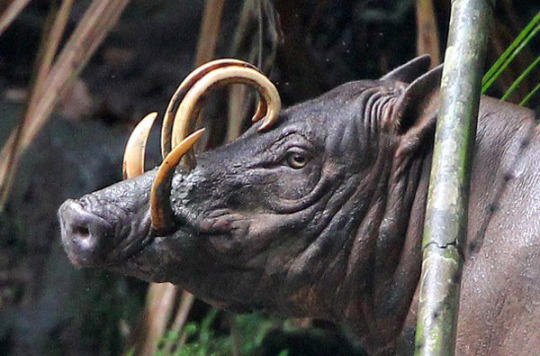



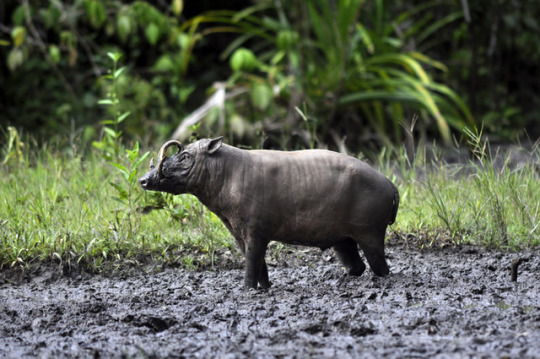
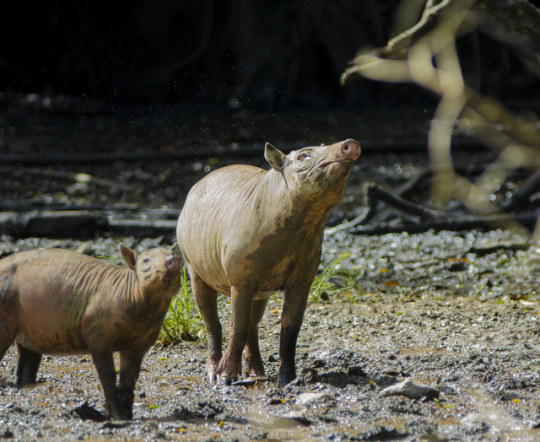


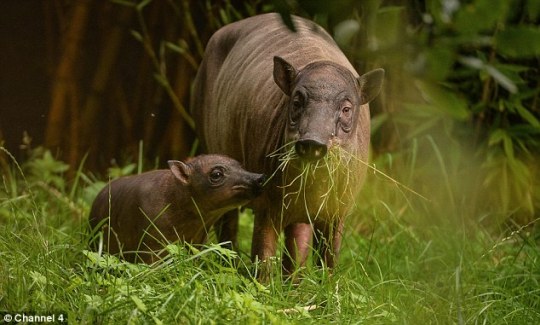
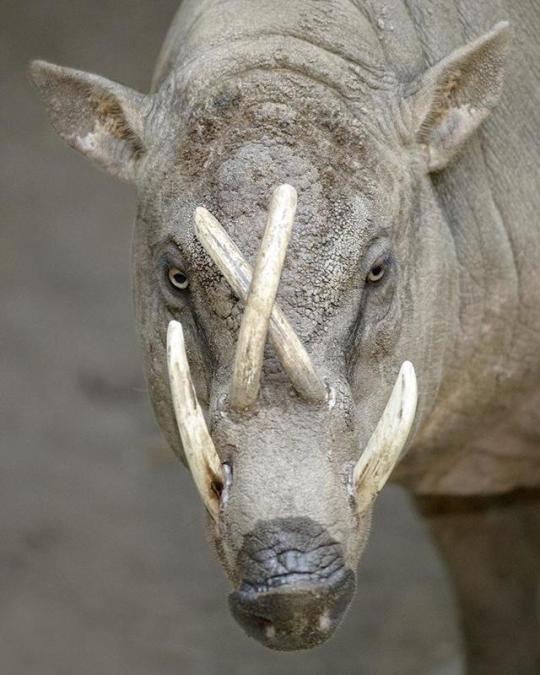

[x]
The babirusas, also called deer-pigs are a genus, Babyrousa, in the swine family found in the Indonesian islands of Sulawesi, Togian, Sula and Buru. All members of this genus were considered part of a single species until 2002, the babirusa, B. babyrussa, but following the split into several species, this scientific name is restricted to the Buru babirusa from Buru and Sula, whereas the best-known species, the north Sulawesi babirusa, is named B. celebensis. The remarkable "prehistoric" appearance of these mammals is largely due to the prominent upwards incurving canine tusks of the males, which actually pierce the flesh in the snout.
All members of the genus were considered part of a single species until recently. The split, which uses the phylogenetic species concept, is based on differences in size, amount of hair on body and tail-tuft, and measurements of the skull and teeth.
Babirusa are notable for the long upper canines in the males. The upper canines of male babirusa emerge vertically from the alveolar process, penetrating through the skin and curving backward over the front of the face and towards the forehead.The lower canines also grow upwards. The canines of the female are either reduced or absent. The structure of the male's canines vary by species. In the golden babirusa, the upper canines are short and slender with the alveolar rotated forward to allow the lower canines to cross the lateral view. The Togian babirusa also has the same characteristics and the upper canines always converge. The North Sulawesi babirusa has long and thick upper canines with a vertically implanted alveolar. This caused the upper canines to emerge vertically and not cross with the lower canines. Babirusa also vary by species in other characteristics. The golden babirusa has a long, thick pelage that is white, creamy gold, black or gold overall and black at the rump. The pelage of the Togian babirusa is also long but not as that of the golden babirusa. The Togian babirusa has a tawny, brown or black pelage that is darker on the upper parts than in the lower parts. The North Sulawesi babirusa has very short hair and appears bald. The female babirusa has only one pair of teats. The litter size for a babirusa is usually one or two piglets.
Babirusa are native to Sulawesi, some of the Togian Islands, the Sula Islands and Buru. In Sulawesi, they range from the northern peninsula to the south and south east provinces. Although babirusas are present on both Sulawesi and Sula, they are not found on the large islands between the two, the Banggai Archipelago. It has been hypothesized that the unusual distribution is due to their being transported by humans as gifts bestowed by native royalty. The preferred habitat of babirusa are tropical rainforests along river banks.
Like all pig species, babirusa have an omnivorous diet with an intestinal tract similar to that of the domestic pig. Because it does not have a rostral bone in the nose, a babirusa does not dig with its snout like other pigs do except in mud and swampy grounds. The diet of the babirusa includes leaves, roots, fruits and animal material. Apparently, the strong jaws of a babirusa are capable of easily cracking hard nuts.
Male babirusa tend to live solitarily while adult females can be found in groups with young. Groups of female and young babirusa may number up to 84 individuals, most of which contain no adult males. Males rarely travel in pairs or trios. The tusks of the adult males are used in intraspecific fighting. The upper tusks are for defense while the lower tusks are offensive weapons. If a babirusa does not grind its tusks (achievable through regular activity), they can eventually keep growing so as to penetrate the animal's own skull.
Babirusas are protected in Indonesia and killing them is illegal in most cases. However, poaching remains a significant threat to the babirusa. Additionally, commercial logging operations threaten the babirusa by habitat loss, and also reduce cover, making the babirusa more exposed to poachers. All extant species of babirusa are listed as vulnerable or endangered by the IUCN.
326 notes
·
View notes
Text
ZooTampa Mini-Review
A wonderfully charming small zoo. The surrounding area and climate of the zoo contribute to a lush, jungle-like atmosphere. Breakdown:
Entrance
Not too many animals in this area. An attractive colonial-style green building welcomes you to ZooTampa in Lowry park. There are 2 animal exhibits in this area: a macaw on a stick exhibit, and an aviary. The macaw-on-a-stick was fairly standard for an exhibit of its type. While I do not approve of these types of exhibits, I do at least have to applaud them for providing shade for the parrot. The aviary was nice; I noted Demoiselle Crane, Inca Tern, and Sacred Ibis in the aviary. The aviary was split into 2 halves with separate exhibits around the outer rim for blue-bellied roller, tawny frogmouth, and Great Indian Hornbill.
Overall: 7/10. The macaw exhibit dragged the quality of this area down, as did the aviary that went against zoogeography, but the aviary was more than adequate for its inhabitants and the lush planting gave the zoo a pleasant atmosphere.
Asia
This area of the zoo, while less lush, treats visitors to less common species in nice exhibits. The first exhibit is for a Malayan Tapir and a Visayan Warty Pig in a sizeable exhibit for both species. Across the way is a komodo dragon exhibit, home to a small komodo dragon in a medium sized mesh exhibit. While I have seen larger exhibits for the species, this exhibit included ramps for use of vertical space, which was a first. Adjacent is a lorikeet aviary of standard size. I was surprised to see the birds inside, while very active, were not at all interested in the food visitors bought. Other species of birds were in the aviary, some of which were separated from the lorikeets bantam chicken being the only other species I recall. Down the path was a fairly large exhibit for a single Malayan tiger, and beyond that a Sulawesi Aviary. Inside the (oddly well-themed) Sulawesi Aviary were Javan Pond Heron, Reeves Muntjac, Victoria Crowned Pigeon, Demoiselle Crane, Masked Lapwing, giant Asian Pond turtle, and more. Next was a large exhibit for a single breeding pair of Indian rhinoceros, which, while not incredibly large, offered incredibly close viewing for guests. Exhibits for gharials and turtles, clouded leopards, and North Sulawesi Babirusa rounded out this exhibit complex.
Overall: 8/10. While a very nice area overall, lack of attention to where these animals live (Demoiselle Cranes, while pretty, are not from Sulawesi...nor were any of the species in that Sulawesi Aviary) makes this slightly less educational than it could be.
Florida
A massive exhibit complex dedicated solely to exhibits for native and introduced wildlife. Sizeable exhibits existed for red wolf, brown pelican, American alligator, an injured bald eagle, key deer, black bear, river otters, and more. The true highlight of this massive complex is a large building full of reptiles, amphibians, and fish, that also includes a stingray touch tank outside, a huge manatee exhibit with 2 large separate exhibits and underwater viewing for the manatees, who cohabitated with native turtle species. Sadly yet fortunately, the manatee exhibits were empty as no injured manatees were "available" for display, and others had been released.
Overall: 10/10. As it would happen, it is hard to mess up the geography of species in your own backyard, and there was not a single substandard exhibit in the area. Everything ranged from above average to excellent, and ZooTampa should be proud.
Africa (by Toto)
A long tunnel leads into what appears to be this small zoo's newest exhibit complex, Africa. This complex includes all the standard fare, elephants, giraffes, zebras (shockingly no lions), but some pleasant species like Okapi (a personal favorite), Marabou Stork, Greater Kudu (another personal favorite) and African Painted Dog, and more. The complex can be viewed by foot, however there are small Savanna style exhibits that can only be viewed by a free safari cart tour.
Overall: 8/10. Africa is done frequently, and while ZooTampa covers little new ground for seasoned zoogoers, the species they do display are displayed well, and while the savanna-style exhibits cannot hold a candle to even the nearby Busch Gardens, they are still large enough for their inhabitants.
Kids/Australia Area
I spent little time here; a small Australian aviary, 2 indoor koala exhibits (home to only 2 koalas total),a wallaby walkthrough exhibit (I skipped this due to seeing something similar at Busch Gardens), and a petting zoo rounded out this area.
Overall: 7/10. Sort of small, pleasant presentation, not much else to say.
Primates
This small complex included exhibits for Bornean Orangutan, ring-tailed lemurs, collared lemurs, siamang, Bolivian Grey Titi Monkey, Golden Lion Tamarin, mandrill, squirrel monkey, and chimpanzee.
Overall: 6/10. All exhibits in this area were perfectly adequate, though the mandrill, orangutan, and chimpanzee exhibits leaned to the small side. I believe I counted 3 rather young orangutans, so evidently they have had breeding success.
Overall
ZooTampa has earned an 8/10. While the zoo is not flashy, and does not have either the means nor the space of Busch Gardens, they do create a more pleasant, laidback visiting experience, and I do not believe I saw an inadequate exhibit on-site. Also the food was pretty good, and I accidentally got a free whole pizza, so, take from that what you will. I look forward to seeing what ZooTampa does in the future, as it will certainly be great.
Stay tuned for Clearwater Marine Aquarium.
1 note
·
View note
Photo

North Sulawesi Babirusa (Babyrousa celebensis) at Brevard Zoo. 2017 https://www.instagram.com/p/CZj64a9rXmj/?utm_medium=tumblr
0 notes
Text
rabirusa
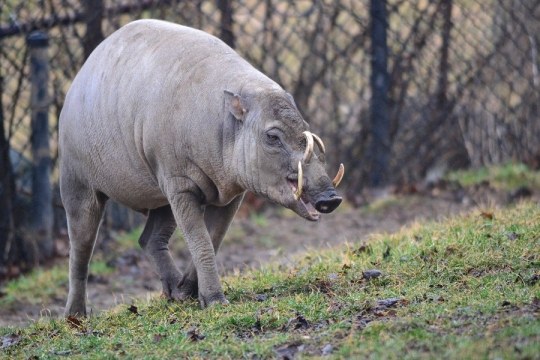
The Sulawesi babirusa (Babyrousa celebensis) is a bizarre-looking mammal, especially males with their curved horns. The appearance of this animal inspired several Indonesians to create demonic masks and even offer individuals of this kind to the visitors as gifts. The name babirusa means "porcupine" because of its cross-face between a pig and a deer, but in reality the Babirus belong to the pig family. Currently, 3 species of babirusa are recognized.
They inhabit the Indonesian island of Sulawesi, specifically, in the north and northeast of the island. They can be found on the banks of rivers and lakes, where there is a greater abundance of aquatic plants. In the old days, the babirusa could be found in low-lying regions, but they have risen to regions upstream and difficult to access to escape the deforestation caused by man.
Babirusa
Front view of a male. Source: Berndt Fischer
The Sulawesi babirusa is the largest among the three species, and is also the least hairy, with scattered fur covering some parts of its grayish-brown, rough skin. The famous horns that the male babirusas present are actually their upper canines, which penetrate through the skin of the nose and then curl towards the forehead. The lower jaw horns also correspond to protruding canines. The canines of the females (smaller size) are either absent or have very small sizes. The function of these peculiar horns is not very clear, since they are fragile and easily break, not being used in combat.
0 notes